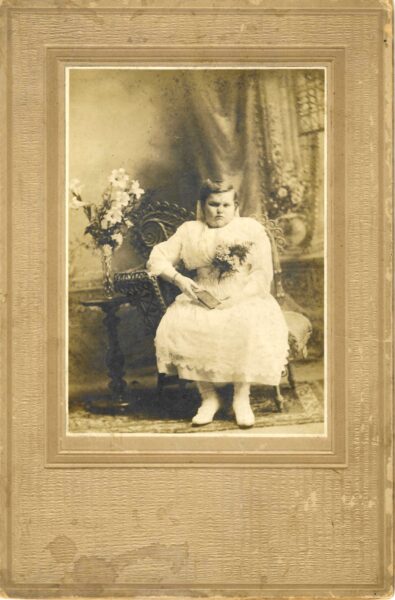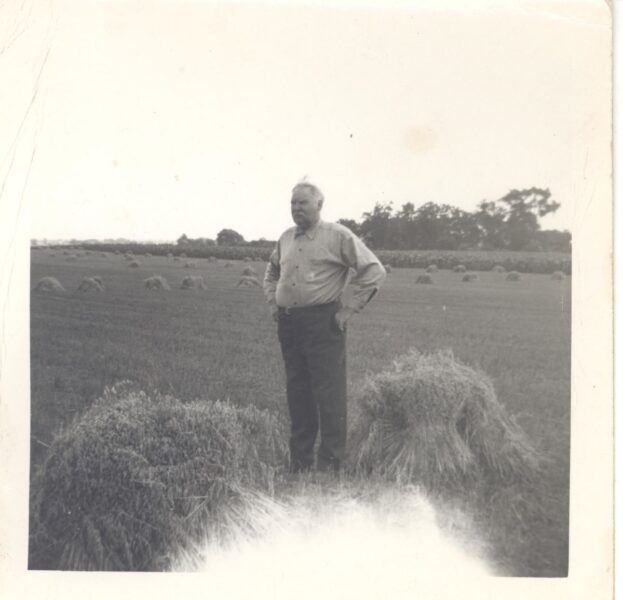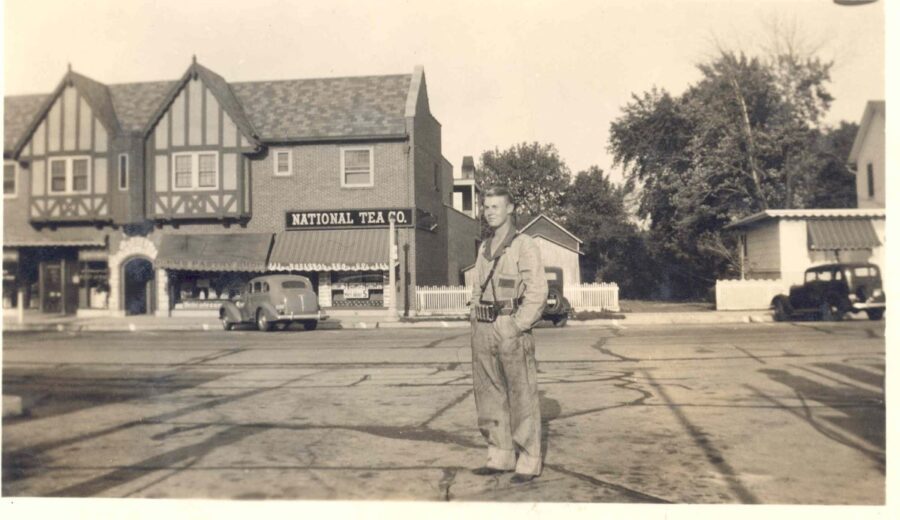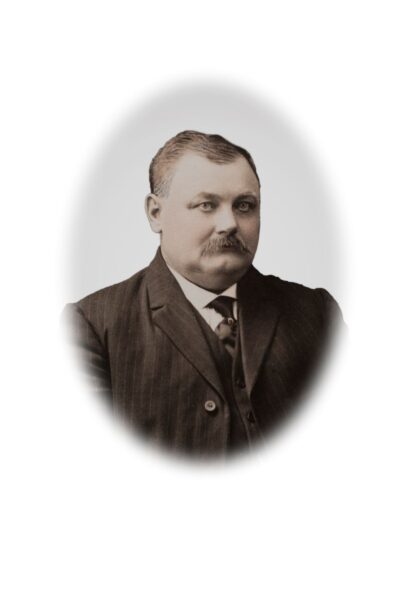
Does MPHS have photographs:
Address in Mount Prospect:
Birth Date: 4/05/190
Death Date: 1/22/1998
Marriage
Date:
Spouse: Alfred Moellenkamp (b. 1904 d. 1988)
Children:
Interesting information on life, career, accomplishments:
Meta Moellenkamp was born in Mount Prospect. Her mother was born on a farm on Mount Prospect Road while her father was born in Mecklenburg, Germany. She married Alfred who lived in a house she passed every day walking to school.
Growing up on a farm, she had a lot of work. She got up every day at 6:00 in the morning and milked 5 or 6 cows and then ate breakfast. She had to walk two and a half miles to school everyday and never was given a ride. She walked along Mount Prospect Road to Golf Road and then down Linneman to the red brick Saint John Lutheran School. On the way home, she would cut through the farm fields. When she got home she would have to milk the cows again and held care for the chickens, pigs, ducks and geese that her family kept. They raised potatoes to sell and sold the milk from the cows, but most of what they raised was for their own consumption. They raised wheat, corn and oats to make flour and hay and corn to feed the animals. They raised other vegetables and fruits, which they canned for the winter, along with meat they canned themselves and ham that they smoked in their smoke house. They also made sausages at home and ate them on sandwiches for lunch. The family bought almost nothing, just things they couldn’t raise on the farm, like sugar, salt, coffee and spices.
She attended school from 1909 to 1917 and in that time had only one teacher, Paul Meeske. There were about 17 kids in her grade and about 80 in the whole school, so the teacher didn’t have a lot of time to spend with each student. Because of this, if students had a problem, the teacher would direct old students to help the younger ones out. The teacher kept a whip and strap at his desk to maintain order. No food and no gum were allowed in the class room. Students all brought their own lunches and ate outside, in the basement, or in the cloak rooms, while Mr. Meeske went home for lunch and left the students alone for a half hour. The students played outside for recess or in the basement. There was no running water in the school. A pail of water was kept at the back of the room to drink and there was one cup for the whole school. At the end of the year they had a big school picnic with a band and ice cream and cracker jack and games.
Oral History
Date of Interview: Unknown
Interviewer: Dorothy Halvoersen
Text of Oral History Interview:
DOROTHY HALVORSEN: Hello, my name is Dorothy Halvorsen, and I am doing an oral history report. I am doing this with Meta Moellenkamp who lives at 255 W. Miller Road, and I am her niece. I have known her all my life, and she is going to tell me things that occurred with her in school, which was St. John’s Lutheran School on Linneman Road, from 1909 to 1917. At that time it was Elk Grove. It was not Mount Prospect at the time, but since then, of course, it has been annexed for many years. She started in first grade, and she went all the way through eighth grade. There was one room, and there was one teacher in this room for all the years that she went. She says that there usually were approximately 17 kids in her class, give and take a couple every years, but usually they were the same. They started with her and they finished with her. When she was confirmed in eighth grade there were 27 of her class that were confirmed because the children came from the public schools. They would go for a confirmation class of two years, and then they would be confirmed in this school. Her teacher was Paul Maeske, all the eight years, with one teacher in the room. She says that her favorite subjects were arithmetic, geography. She liked everything –catechism songs, there is penmanship, history, and she liked arithmetic the best. She says there were lots that copied her answers because she was pretty good in that. She remembers that there was a desk with a bench, and there were two that sat on the bench together. The back of the bench was the front of the desk behind you. There was an inkwell. Each person had an inkwell, and, of course, if the children had long hair the boys behind would often like to stick the hair into the inkwell. She said she lived two-and-a-half miles away. She lived on Mt. Prospect Road. If you know where that is, near Thacker Street, and she had to walk all the way down Mt. Prospect Road to Golf Road and then over to Linneman Road. She did this by herself, she said, all eight years. She walked every single day, regardless of the weather. Sometimes when she was on Golf Road a family named Holste would call her in and she would get warmed up there. When she went home she went across the fields, she said. There was like a little dividing area between some farms, like a hardened road — Miller Road was not there at the time –and she would walk home that way. School started at nine o’clock and ended at three thirty. She got up at six o’clock in the morning because she had to milk five or six cows. She always had breakfast. Her mom or older sister made breakfast. They had pancakes and bacon or oatmeal. Those were the only two things that they had. Winter and summer it was always the same. There were no dry cereal boxes at that time. She would take a lunch along with her. Her parents always made her a sandwich. There was either summer sausage or jelly, and she always had a piece of cake with it. The bread was always homemade white bread. There was no fruit. They just never brought any fruit. They would have the fruit that they raised in the summer, and that would be it. Everybody ate lunch at school, and they could not eat in the classrooms. They would have to walk back by the cloakroom, in the basement, or outside, depending on the weather –all except the teachers, and, would you believe, the teacher went home to eat for half an hour and he left all the students by themselves. The school started with the Lord’s Prayer first, and then they would sing from a hymnal, and then they had a religion class and a catechism class. They had to memorize many, many things. You had to memorize parts of the catechism, the hymns and all the Bible stories, and then they would take turns going into the front, walking up to the front, and relating the different stories. She says that she does not remember the Pledge of Allegiance until later in school, perhaps in the seventh or eighth grade. There was a lot of memorizing. They wrote on the blackboard, they wrote on tablets of paper. She always had homework. She had to do the memorizing at home. And they had books. She had her own geography book, history book, catechism, and the Bible history book. There was a piano in the room, and they sang songs, but she says only religious songs. It would only be later, in the seventh and eighth grade, that she remembers singing anything at all patriotic. Can you imagine being in a room with eighty-two students and one teacher, and how would this be? The teacher would call the older students to help, she says, and that worked real well. She says that if somebody had difficulty they would raise their hand –it would go up in the problem — they he would call another child and say, “Come on over there, and you help that child.” There was a school bell that rang at nine o’clock, and when recess was over they would be called back by the school bell. Recess in the morning was about fifteen minutes. There was a big thing about no gum chewing, no eating in the school room and, like I said before, they ate lunch in the cloakroom. There also was no running water, and there was a pail of water that was back of the classroom by the cloakroom, and when the pail ran out somebody would walk down the road –on Linneman Road there was a well there –and get it filled. They all drank from the same cup. She always wore dresses, and mostly all, of course, were homemade. She says she changed them twice a week. She would start off, probably, Monday, Tuesday, Wednesday wearing the same thing, Thursday, Friday, change the dress. They always wore long stockings and high-top shoes with buttons. She said some kids seemed to wear the same clothes all winter long. The teacher always wore a suit. At play or recess the girls played a baseball game called “Penny Over Hand,” and the boys had a baseball field for themselves where they would play. They also played jacks-and-ball. They played with a pocketknife where two kids would sit facing two other children together, and they would flip it over and it would have to hit into the ground. In the winter they played in the basement. She remembers playing hide-and-go-seek. Of course, there was no playground equipment at the time. Like I said, the teacher went home at lunch time for half and hour, and he left all these children by themselves. She said she never remembers anyone getting hurt or in trouble during that time. The teacher had a whip and a strap. We hate to say things like this, but at that time it did. He used it very infrequently, but she says she remembers it being used a couple of times. And, she said, boys, not girls. If you were tardy –and I remember, I went to school there. I was the next generation, and it was under his desk and he would say something about a strap. I never saw it being used, but I knew it was there. If you were tardy you had to stand by the door until the teacher said to go sit down. There were no arts and crafts or things like that. It was strictly reading, writing and arithmetic. Now, she liked him. She said he was always very good to her. He was very strict, and he kept good order. Her favorite things were the Christmas program on Christmas Eve. When she was in first grade she said she sang a solo, and the second year she and Irvin Busse sang a duet together. Then later she sang with a group, all the time, but she was always one of the singers. Then during the program they would sing songs and sing the Christmas songs, and then they had memorized several parts of the Bible, the nativity, and then they would read that. At the end they would get a bag that had apples and nuts in it. She always went to church in a horse and buggy. They went to church every Sunday. The women sat on one side and the men on the other. The women, of course, always wore a hat. Now, like I said, they always took the horse and buggy to church, but never did she ever get a ride to school. At the end of the school year was a school picnic, and that was a lot of fun. There was a band that played. They could buy ice cream, pop and Cracker Jack for a nickel. They had a flag drill that the kids would wave flags in, and they would march around. They also played a game with a fishing well. There was a blanket on the corner of the building, and then a man would hold a fishing rod and you would give him your nickel, or whatever, and then somebody would attach some toy to the [hook]. That was lots of fun. We played this, too. My next generation also played this. And then there were games played in the lawn that they didn’t play in school, like London Bridge and simple things like that.
After school she had more chores. She had to milk the cows again –cows have got to be milked in the morning and in the evening –and they had chicken, pigs, ducks and geese, and they all had to be fed and watered, and they had to carry the water to the animals from a pump that was in the middle of the yard. They raised potatoes, and that was the only thing that they did sell. The other things that they raised were corn, oats and wheat, and those were all used, really, by them and by the animals. They used their own wheat to make their own flour. Every day they had eight cans of milk, and her father would take this to the Mt. Prospect creamery or the Des Plaines creamery. Their free time after school was visiting. She says almost every Sunday they would have company. Relatives came from Chicago most of the time, and her mother always had cakes and something for them to eat. The children mainly played by swinging. They had a swing in the trees, and there were plenty of neighbors. She said she had lots of friends that came over. There was a Erleking family nearby that had a number of children. They also had roasts for their Sunday meals, and he sister made excellent pies and she would make a jelly roll that was very popular. They never bought anything canned. They even canned their own meat. They would can the meat in jars. They also had a smokehouse, and they smoked their own hams. They also made sausages, and these sausages were kept in a cool place. She said they couldn’t be frozen, but that’s what they would have for lunch meat. The only thing she remembers buying at a store were things like staples –sugar, coffee, spices, salt and probably oatmeal –but everything else they had at home, and they always had plenty to eat. She does not remember any graduation ceremonies after the school year. Also, she doesn’t remember any high school being around here nor any of her classmates going to high school. The big occasion was confirmation. That was always on Palm Sunday, and the girls would always wear a very pretty white dress. The pictures were taken of them –a formal picture taken –that they would give to all of their relatives later. That was a big time in their life, and the boys, of course, wore a suit. The confirmation classes were held in back of the church, and the minister taught them for the last two years. Since I mentioned they had no running water they also did not have bathrooms in the school. They had an outhouse outside, and the boys’ was on one side of the school and the girls’ was on the other side of the school. They also spoke German. They had the Bible, which they learned from there, and they spoke together in German many times, and English. So through those eight years they learned both English and German. I want to just give you some additional biographical information. Her name was Meta Moeller before she was married. Her mother’s name was Dorothea Mueller, and her mother was born on the farm on Mt. Prospect Road, also. [Dorothea’s] husband’s name was Christian Moeller, and he was born in Mecklenburg, Germany. Meta married Alfred Moellenkamp who lived on Golf Road –she passed the house every day when she went to school –and they bought the property on Miller Road. They resided on Miller Road, where she is still living, all their married lives. They farmed that area. Now it is all built up with homes, but all their married life they did farming. I thank Meta Moellenkamp for offering to be interviewed.


